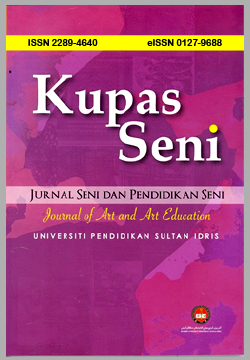Cultural values in Coca-cola animated advertisement: Chinese New Year (2022-2023)
DOI:
https://doi.org/10.37134/kupasseni.vol13.1.3.2025Keywords:
Cultural value, Animated advertisements (Animated ads), Chinese New Year (CNY)Abstract
With Chinese immigrants spreading across the globe, the Chinese New Year has gradually become a global festival. Along with advancements in information technology and the close connection between media and culture, the ways of presenting animated advertisements are becoming increasingly diverse. Most research focuses either on advertisements or animations, with less emphasis on those appearing in animated ads. The culture of the Chinese New Year has become an important element in animated advertisements. This study primarily uses qualitative research methods to analyze the dominant cultural values in two Coca-Cola Chinese New Year animated advertisements. Data analysis employs Roland Barthes' semiotic analysis. The study examines the content analysis results, which show that the values include tradition, harmony, etiquette, benevolence, face, family, filial piety, perseverance, wisdom, nature, beauty, youth, modernity, happiness, and enjoyment. It is evident that Chinese animated advertisements not only convey Chinese cultural values but also incorporate cultural values from other countries. Furthermore, it highlights the significant role of Chinese cultural values in animated advertisements.
Downloads
References
Song, Y., & Zhang, Y. B. (2008). Cultural values in Chinese children’s animation: A content analysis of The Legend of Nezha. Retrieved from https://kuscholarworks.ku.edu/handle/1808/6879
Zhang, Y. B., & Harwood, J. (2004). Modernization and tradition in an age of globalization: Cultural values in Chinese television commercials. Journal of Communication, 54. https://doi.org/10.1111/j.1460-2466.2004.tb02619.x
Smith, J. (2023). The rise of animated advertising in the digital age. Marketing Journal, 15(2), 123–135.
Tanaka, M. (2021). Cultural impact of Japanese animation in global advertising. Journal of Cultural Studies, 8(3), 200–215.
Lee, K. (2022). Ethical considerations in animated advertising: A cultural perspective. International Journal of Advertising, 29(4), 456–470.
Bond, M. H. (1996). Chinese values. In M. H. Bond (Ed.), The handbook of Chinese psychology (pp. 208–226). New York: Oxford University Press.
Tang, T. N., & Dion, K. L. (1999). Gender and acculturation in relation to traditionalism: Perceptions of self and parents among Chinese students. Sex Roles, 41, 17–29.
Yang, K. S. (1996). The psychological transformation of the Chinese people as a result of societal modernization. In M. H. Bond (Ed.), The handbook of Chinese psychology (pp. 478–498). New York: Oxford University Press.
The Chinese Culture Connection. (1987). Chinese values and the search for culture-free dimensions of culture. Journal of Cross-Cultural Psychology, 18, 143–164.
Lin, C. A. (2001). Cultural values reflected in Chinese and American television advertising. Journal of Advertising, 3, 83–94.
Penny, B. (2006). Daoism in history. UK: Routledge.
Qiao, T. B. (2005). Chinese animation market: Monkey King vs. Mickey Mouse. China Today. Retrieved November 30, 2007, from http://www.chinatoday.com.cn/English/e2005/e200506/p21.htm
Zhang, Y. B., & Harwood, J. (2002). Television viewing and perceptions of traditional Chinese values among Chinese college students. Journal of Broadcasting & Electronic Media, 46, 245–265.
Chen, G. M., & Chen, V. (2002). An examination of PRC business negotiations. Communication Research Reports, 19, 399–408.
Sobur, A. (2006). Semiotika komunikasi. PT. Remaja Rosdakarya.
Downloads
Published
How to Cite
Issue
Section
License
Copyright (c) 2025 Liu Jingrou, Nur Syuhada Mat Sin, Zhang Ran

This work is licensed under a Creative Commons Attribution-NonCommercial-ShareAlike 4.0 International License.





